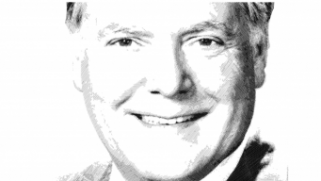Friends
by Jeffrey Saut, Chief Investment Strategist, Raymond James
“Thank you for being a friend
Traveled down the road and back again
your heart is true you're a pal and a confidant.”
. . . Andrew Gold, All This and Heaven Too (1978)
“Friends” . . . except in this case I am not referring to the 1994 TV sitcom, but the true friends I have met over the past 45 years in this business. I thought about this theme two weeks ago as I was sitting in Bobby Van’s, across from the NYSE, listening to great stories from my friend Art Cashin and Eric Kaufman (captain of the sagacious VE Capital), and other members of Friends of Fermentation (FOF). As I listened to Arthur, I could not shake the feeling that these classic Wall Street stories need to be scribed lest they be lost forever. Regrettably, too many of my friends’, and stock market icons’, stories have been lost forever. One of the best writers I ever knew on the Street of Dreams was my friend Barton Biggs (Morgan Stanley). Most do not know that Barton was an English major at Yale, who studied under poet and novelist Robert Penn Warren, and was a member of the secret society Elihu. No wonder he was such a great writer! To be sure, most of Barton’s personal stories were lost when he passed away in 2012, WAY too soon. In 1974 I had the privilege of talking with Larry Tisch, businessman, CEO of Loews Corporation, legendary investor, and billionaire. In said meeting I asked him why he was buying shares of Overseas Ship Group (OSG). He responded, “Kid, I can buy the entire company out at its current market capitalization, melt down the ships, and sell the scrap steel for twice what I am paying for the stock.” Hereto, such stories have been lost with his death in 2003. Other deceased notables included: Alan “Ace” Greenberg (Bear Stearns); Henry Singleton (Teledyne); Muriel Siebert; Marty Zweig . . . well, you get the idea.
This “stories” theme was reinforced recently by a phone call I got from someone I didn’t even know. That call was from Bill Brown, a Wall Street veteran of some 42 years. Bill currently hangs his hat at RBC, a firm he refers to as “a place where people care about people,” which I said, “Yep, that sounds a lot like Raymond James’ culture!” Bill related that Michael Metz, another Wall Street icon with Oppenheimer & Co. that I never met or talked to, had given Bill a task. Mr. Metz’s task to Bill was a list of six rising stock market pundits he read every week, but was too shy to pick up the phone and talk to. His request was that upon his death, Bill was to contact all six and relate that Mike Metz “liked their insights and style.” Bill told me he had been able to find five of those folks, but had missed the sixth. He continued, “A few weeks ago, one of our RBC brokers left the firm for Raymond James and began sending me your reports. While it took a few of them to sink in, I realized that you were the sixth rising guru that Michael wanted me to contact.” My response, “I am truly humbled because Michael was brilliant and I regret I never got the chance to talk to him.” Alas, many of us need to write a book before such stories are lost forever.
Speaking of “forever,” only “Diamonds are forever,” a mantra that unfortunately has been pointed out to holders of stocks like Enron, where participants refused to manage the risk. As stated in every presentation I give is a quote from Benjamin Graham that reads, “The essence of portfolio management is the management of ‘risks,’ not the management of ‘returns’. All good portfolio management begins and ends with this tenet!” My father put it much more succinctly when he said, “Son, if you manage the downside in portfolios, the upside will take care of itself. Avoiding the big loss is the key to successful investing.” Unfortunately, too many folks tell me, “Nobody can ‘time’ the stock market, therefore you should stay fully invested all of the time.” I would respond that I disagree, if your time horizon is 20 years I agree, but if your timeframe is less, if you listen to the message of the market you can certainly decide if you should be playing “hard,” or not so “hard.” We played “hard” at the August 24/25th lows, and again at the envisioned downside retest of those lows in late September. More recently, we have suggested a much more cautious approach above our 2080 “pivot point” (basis the S&P 500). Is the subsequent envisioned decline back into the support level of 2020 a reliable “buy” point? Quite frankly, I just don’t know, believing the downside is not yet complete. Maybe that will happen today/tomorrow with another Turning Tuesday. As another friend, none other than the brilliant Dallas-based “seer” Frederick “Shad” Rowe writes:
Formerly, Americans with capital could feel financially safe owning various businesses (newspapers, television stations, oil and gas production, etc.) or owning a diversified portfolio of “quality” companies and not only survive but prosper. That is no longer the case. Further, it seems to me that the inflation rate is grossly understated, which means that cash or bonds are not “safe,” either. In short, formerly “safe” investments are not so safe. Instead, the one world we currently occupy is increasingly a “winner-take-all society” in which there will be fewer but bigger winners. It is a world, moreover, that is fraught with tremendous reward and risk. All of us understand that technology displaces jobs in the short run. But in the long run, we are all better off. Similarly, it seems to me that technology is displacing capital itself at an alarming rate, which will be painful. But again, in the long run we will be better off. Why? . . . because we always have been.
As feared, the S&P 500 (SPX/2023.04) sliced right through the 2040 – 2050 support zone and is now resting on secondary support between 1993 and 2020 (see chart 1 on page 3). Also worth mentioning is that the SPX has traded below its 200-day moving average (DMA) for two consecutive days. That brings into play the SPX’s 50-DMA at 2007.68. If that level is violated it calls into question the viability of the fabled year-end rally. Troubling is that the S&P 600 SmallCap Index may be pointing the way lower as it is in jeopardy of traveling below its respective 50-DMA (chart 2). Andrew and I have counseled for caution over the past few weeks because our models/indicators suggested such. Indeed, we have often stated that those models never turned positive despite “calls” for us to “throw in the towel and admit we were wrong” two weeks ago with the SPX probing its highs. While we are often wrong, we will continue to trust our indicators that have served us so well over the years. If you do not agree with our current cautionary stance we would put these names on your watch list for potential purchase because they beat both earnings and revenue estimates and raised forward guidance. They are also rated positively by our fundamental analysts and screen well by our algorithms. The list includes: Alphabet (GOOG/$717.00/Outperform); Boston Scientific (BSX/$17.51/Strong Buy); DR Horton (DHI/$30.67/Outperform); Estee Lauder (EL/$82.66/Outperform); NVIDIA (NVDA/$29.80/Strong Buy); and Texas Instruments (TXN/$56.13/Strong Buy).
As for the Russian airliner and the Paris tragedies, while these events will likely impact tourism and travel, they may have FINALLY united the world. I am reminded of the quote by Admiral Yamamoto after the attack on Pearl Harbor when he said, “I fear all we have done is to awaken a sleeping giant and fill him with terrible resolve!” I will relate that such events have tended to reside around stock market lows.
The call for this week: Our models called the downturn beginning in July, as well as calling the bottom on August 24th. We subsequently said that a bottom is typically a process and not an event. What you tend to see is a capitulation low (August 24th) followed by failed rally attempts. Then, the market comes back down and tests the capitulation low. That is what happened in late September and we recommended mutual funds and stocks at the August and September lows. What followed was a double-bottom (W-shaped) in the charts. However, more recently our models have been calling for a more cautionary stance and we have complied. Hopefully, this recent weakness will have a positive resolution this week. Until then, we are operating under the prime directive of investing . . . “Do no harm.”
Copyright © Raymond James


















